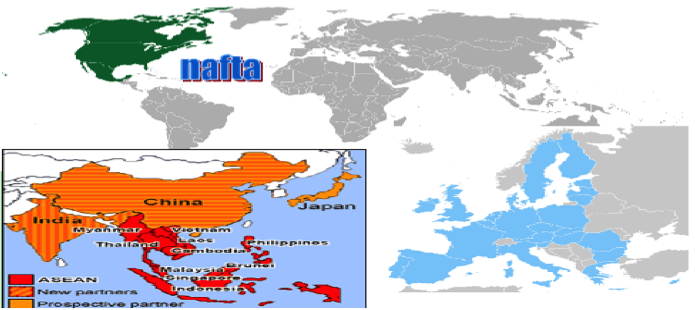Trade and Growth
Why does growing trade help economies?
Growing trades allows specialisation in products with lowest opportunity cost. Specialisation allows economies of scale. Rising exports create demand, increasing incomes/standards of living and a positive growth cycle.
Trade barriers (tariffs and quotas) prevent all this.
Trade liberalisation
Since WWII there has been a reduction in tariffs (import taxes) on manufactured goods – thanks to the General Agreement on Trade and Tariffs (GATT), and laterally, the World Trade Organisation (WTO). This is known as TRADE LIBERALISATION – the process of limiting and reducing trade barriers so that economies can move closer to free trade.
The removal of many trade barriers, the creation and expansion of trade blocs and the expansion of the WTO (China joined in 2001) has opened the world to trade. These jumps forward will be further echoed if the TPP and TTIP agreements go ahead.
Specialisation and International Trade
Division of labour: __Production process is split up into different tasks and each worker performs one of these tasks. It is also known as __specialistaion.
So specialisation on a business level makes sense. It also makes a lot of sense on an economy to economy level. With international trade, economies become specialised, each producing the things they are best placed to produce. Their advantages may include natural resources, abundant land, cheap labour, scarce skills, climate, deep-water port, university specialism or accessible sources of finance.
A good example is the specialisation of each of the countries within the EU. This specialisation encourages trade between countries thus increasing GDP and standards of living for all. It’s a much better approach than everyone competing (‘absolute advantage vs comparative advantage’ is the more formal economic way of phrasing this.
When you start to think about international trade, you see at once that economies become specialised – each producing the things they are best placed to produce. Their advantage may include natural resources, land, cheap labour, scarce skills, technical know-how, a favourable climate, beautiful scenery, a deep-water port, universities or accessible sources of finance.
Globalisation has made economies much more interdependent. Specialisation means that many needs will be met by imports. Big projects require international finance to fund large-scale investments (e.g. Chinese investment in Greek ports). These trends are positive for most, though those with limited/undesirable skill sets may experience significant income losses.
Trade liberalisation and economic growth: Trading blocs breed free trade and generally this encourages specialisation and economic growth for all via trade. Thanks to the WTO’s objective of global free trade, this will only continue – but BREXIT and Trump’s America have taken a step back from globalisation and free trade and may well encourage trade barriers. It will be a very interesting next few years as this all pans out!
So what does the future hold for this post-BREXIT, anti-globalisation and anti-MNC world? Will trade return to strong growth levels? Or will trade slow/grow more slowly? Why? Take time to reflect on current affairs.
Foreign Direct Investment (FDI)
Many MNCs have embraced globalisation, finding growing markets in emerging economies highly attractive. __FDI __drives trade, with developed economies attracting the most FDI as a ‘safe bet’ – e.g. USA is the world’s no.1 attractor of foreign capital by a long way! The poorest countries see very little FDI because few MNCs see prospects of profits there.
FDI is all about capital investments flowing between one economy and another. It facilitates trade and is changing in many ways.
The recent slowdown in international trade is reflected in the FDI figures (global FDI fell by 28% in 2014 and fell in Europe by 11% (UN data)). Some experts expect FDI to recover, but the outlook seems rather bleak.
Let’s see what the Getting Started Guide has to say:
3.1.2 Trade and growth
a) Students should be aware that trade liberalisation has been an increasing phenomenon in recent years. This has been brought about by several factors, including political and social change, expansion of trading blocs and the role of the World Trade Organisation (WTO).
b) By specialising, countries can gain a competitive advantage in terms of lower average costs and reputation. Examples might include: Brazil and commodities such as soya, iron ore and sugar; India and IT services; Russia and energy supply; and the UK and financial services. Students need to be aware of both the advantages and disadvantages of specialisation.
c) Trade liberalisation can lead to reduced costs of trade, greater choice, lower prices, a rise in disposable income for consumers and an expansion of potential markets for businesses. All of these should lead to economic growth.
d) Students should understand the nature and trends of FDI, particularly that it is not just something that happens to developing nations. The impacts of FDI may include increases in employment, income and tax revenue, and subsequent economic growth. The multiplier concept is useful here. Students are not required to study the theory of comparative advantage. However, they should have an understanding that, if countries specialise in what they do best or least badly and then trade, economic growth is likely.

